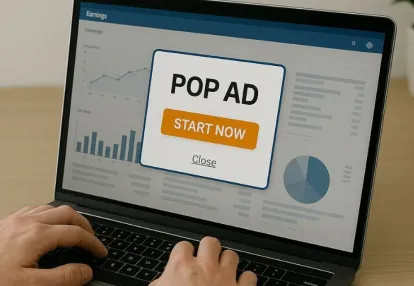
Our spy tools monitor millions of popup and pop-under from over 90+ countries and thousands of publishers.
Get StartedPop-up advertising has become a prevalent tool in online marketing strategies. These advertisements, which appear suddenly over a webpage or app, aim to capture immediate attention from users. Their design often includes compelling visuals and urgent calls-to-action, making them hard to ignore.
Understanding the impact of pop-up ads on consumer purchasing behavior is crucial for advertisers and marketers. By analyzing how these ads influence decisions, businesses can fine-tune their strategies for optimal results. Despite their widespread use, the effectiveness of pop-up ads remains a subject of debate.
The online advertising landscape is vast, with social media platforms playing a significant role in displaying pop-up ads. Platforms like Facebook and Instagram integrate these ads seamlessly into user feeds, leveraging their massive user base for targeted marketing campaigns.
Advertisers often struggle with balancing the intrusiveness of pop-ups against their potential benefits. The challenge lies in creating ads that engage without causing frustration. Studies indicate that while some users find these ads intrusive, others may be driven to make quick purchasing decisions due to the sense of urgency they create.
For insights into successful pop-up advertising tactics, you might explore resources such as Anstrex's guide on pop ads. These guides can help you understand how to succeed at massively scalable pop advertising by revealing closely guarded secrets of other successful advertisers.
It's worth noting that there are variations of pop-up ads like popunders, which are less intrusive since they do not immediately disrupt the user's viewing experience unlike traditional pop-ups that open over the top of web content. This distinction is vital because some advertisers worry about the negative impact on SEO efforts caused by excessive use of pop-up ads.
Pop-up ads use psychology to grab the attention of social media users and convince them to make a purchase. Here's how they do it:
Studies have shown that surprise and novelty can make internet ads more engaging. By showing something new or unexpected, pop-up ads can briefly distract users from what they're doing and get them interested in the ad content.
These tactics aim to create a sense of urgency and trigger emotional responses in consumers. Research suggests that such urgency-driven messages can effectively increase conversion rates by pushing users to make quicker decisions.
For those interested in a deeper dive into how these psychological mechanisms play out in different cultural contexts, you might find this quantitative analysis involving user perceptions highly relevant.
By understanding these psychological principles, advertisers and marketers can create more compelling pop-up campaigns that not only grab attention but also drive consumer purchasing behavior effectively.
Pop-up ads have a significant impact on consumer perception and attitudes. The effectiveness of these ads is often debated, with varying opinions based on feedback from both consumers and advertisers.
Advertisers are constantly evaluating the viability of pop-up ads within their marketing strategies. Despite the common perception that pop-up ads are intrusive, some advertisers argue they remain an effective tool for capturing attention and driving conversions. Key points from their perspective include:
Contrary to these benefits, many studies indicate a general aversion to pop-up ads among social media users, which may undermine their overall effectiveness.
Balancing ad intrusiveness with relevance and value is critical for maintaining a positive user experience. Consumers often express negative attitudes towards pop-up ads due to their disruptive nature. However, there are strategies that can mitigate these challenges:
Understanding these nuances helps marketers create more effective campaigns that respect user preferences while achieving advertising goals.
Pop-up ads can evoke varied reactions from internet users depending on cultural contexts. Cross-cultural advertising shows that understanding these cultural nuances is crucial for creating effective marketing strategies.
In Ghana, internet usage has seen significant growth, leading advertisers to explore digital marketing strategies tailored to Ghanaian audiences. Cultural values play a pivotal role in shaping the perception and effectiveness of pop-up ads.
Ghanaian society tends to be more collectivist, emphasizing community and social harmony. Pop-up ads that align with these values by promoting community-oriented products or services may resonate better.
Emphasizing traditional values and local culture in advertisements can enhance their appeal. Pop-ups featuring culturally relevant content or references can capture attention effectively.
Ghanaians often trust recommendations from local influencers and leaders. Pop-up ads incorporating endorsements from respected local figures can improve credibility and engagement.
Pop-up ads in Ghana can leverage specific cultural elements to stand out:
Understanding these cultural factors enables marketers to design pop-up ads that are not only less intrusive but also more relevant and engaging for Ghanaian internet users. This approach helps in creating a balanced advertising strategy that respects cultural values while achieving marketing objectives.
Advertisers and marketers can use pop-up ads effectively by focusing on strategies that improve user experience instead of making it worse.
Practical Recommendations:
Non-disruptive formats ensure users remain engaged without feeling interrupted:
For instance, Sleeknote leverages scroll-triggered pop-ups that suggest users sign up for newsletters after they have shown engagement with content. This method respects user intent while still promoting conversion goals.
Segmentation ensures that pop-ups are delivered to users who are most likely to find them valuable:
By using advanced targeting methods, advertisers can make sure their messages resonate with specific audience groups. For example, an e-commerce site might use demographic data to present fashion discounts tailored to young adults during peak shopping seasons.
These approaches highlight how understanding consumer purchasing behavior within online advertising on social media platforms can lead to more effective and less intrusive pop-up ad campaigns.
Emerging trends in online advertising are expected to reshape the landscape of pop-up ads. Advancements in artificial intelligence (AI) and machine learning enable more personalized ad experiences, reducing perceived intrusiveness. AI can analyze user behavior to serve ads that align closely with individual preferences.
Interactive content is another trend gaining traction. Pop-up ads featuring quizzes, polls, or short videos engage users more effectively than static ads. This interactive approach can lead to higher conversion rates by making the ad experience enjoyable.
Augmented reality (AR) is also set to revolutionize pop-up advertising. AR-enhanced ads offer immersive experiences that capture user attention more naturally, potentially improving attitudes towards these ads and increasing their impact on purchasing decisions.
Adopting user-centric approaches in pop-up ad design and targeting strategies is crucial. Understanding what users find valuable and non-intrusive helps create a positive interaction.
Incorporating these elements can help marketers maintain the effectiveness of pop-up ads while adapting to evolving consumer landscapes.
Pop-up advertising definitely influences consumer purchasing behavior. It's important for advertisers and marketers to find a balance between effective advertising and a positive user experience. Here are some ways to achieve that:
By following these guidelines, you can make your campaigns more successful while still providing a good user experience. This approach will result in higher levels of engagement and better outcomes in online advertising. Prioritizing transparency and user privacy is key to staying successful in the ever-changing digital world.
Receive top converting landing pages in your inbox every week from us.
Case Study
Pop ads are one of the most cost-effective ways to generate traffic in digital marketing today. These advertising formats—including popups and popunders—bypass banner blindness while delivering impressive click-through rates that traditional display ads struggle to match.
Priya Kapoor
7 minOct 8, 2025
Tips & Tricks
Creative fatigue in pop ads is one of the biggest challenges digital marketers face today. This happens when your audience sees your ads too often and becomes uninterested, leading to a significant drop in engagement, click-through rates, and overall campaign effectiveness. You may have experienced this yourself - when an ad that used to work well suddenly stops performing, leaving you confused about what went wrong.
Marcus Chen
7 minSep 20, 2025
Quick Read
Pop ads have become one of the most powerful tools in affiliate marketing, catching the attention of top marketers around the world. These eye-catching ads bring in large amounts of traffic at competitive prices, making them the preferred choice for affiliates who want to quickly grow their campaigns.
David Kim
7 minSep 8, 2025




